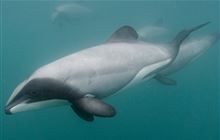Dead Hector’s dolphin at Te Waewae Bay, Southland
Archived content: This media release was accurate on the date of publication.
Introduction
A dead adult Hector’s dolphin was discovered at Te Waewae Bay in Southland at the weekend.Date: 10 May 2022
Department of Conservation (DOC) Aquatic Director Elizabeth Heeg says the adult female dolphin was found by a member of the public on 7 May. DOC staff were able to retrieve the body and have sent it to Massey University for examination.
“Sadly, this is the fifteenth Hector’s dolphin found dead around the South Island since early November 2021,” Elizabeth Heeg says.
“At this stage we don’t know why we’ve had this many Hector’s dolphins wash up over the past six months. We’re waiting for the remaining necropsy results to understand more about possible causes of death.”
Eight of the recent deaths were calves. A very decomposed and scavenged Māui dolphin was also found at Muriwai, west of Auckland, on Christmas Day but was not collected.
When dead dolphins are reported and retrieved quickly, they can be chilled and sent to the pathologist. Thirteen of the dolphins found since November last year have been sent to Massey University.
“They are gradually being examined by the pathologist. So far, we’ve had results back from necropsies on eight of the dolphins,” Elizabeth Heeg says.
None of the dolphins showed any evidence of being caught in fishing nets. The causes of death results received to date have indicated a mix of natural causes – maternal separation (calves), disease and predation.
“There are approximately 15,700 Hector’s dolphins around the South Island. The death of any dolphin is always unfortunate, but not entirely unexpected, and isn’t likely to have an impact on the population as a whole,” she says.
“Clusters of death raise questions about whether they might be connected and a sign of something else going on in the dolphins’ environment. Equally it could just be a coincidence, and a year in which the number of deaths is at the high end of ‘normal’ mortality for the population.”
She thanked the member of the public who reported the dead dolphin. “When people are quick to alert us to discoveries of dead dolphins, it increases the volume and value of the information we can obtain.
“We urge anyone finding a dead Hector’s or Māui dolphin to report it to DOC via 0800 DOC HOT (0800 362 468). It is also important for the public to report live sightings via the DOC website, or the hotline.”
DOC manages a Hector’s and Māui dolphin sightings database, and incident database, both of which help inform management actions to protect the dolphins.
Results are shared on the DOC website when available.
Background information
Hector’s dolphins are the world’s smallest dolphin species, with adults measuring about 1.5 m long.
Identifiable through their distinctive round dorsal fins, Hector’s dolphins’ bodies are grey with black and white markings. The population is estimated to be around 15,000 and they are classified as Nationally Vulnerable in the National Threat Classification System.
Hector’s and Māui dolphin bodies are routinely sent to Massey University for necropsy to obtain information such as cause of death (when this can be determined), including examination for disease. Information on the sex, body condition and other biological information is also recorded.
The level of decomposition of a dolphin carcass, and whether it has been frozen, are key factors in how much information can be determined.
The work to protect both Hector’s and Māui dolphins is guided by the Hector’s and Māui Dolphins Threat Management Plan. Management actions to date include Marine Mammal Sanctuaries and restrictions on fishing methods that pose a significant threat, including set netting and trawling.
Contact
For media enquiries contact:
Email: media@doc.govt.nz

